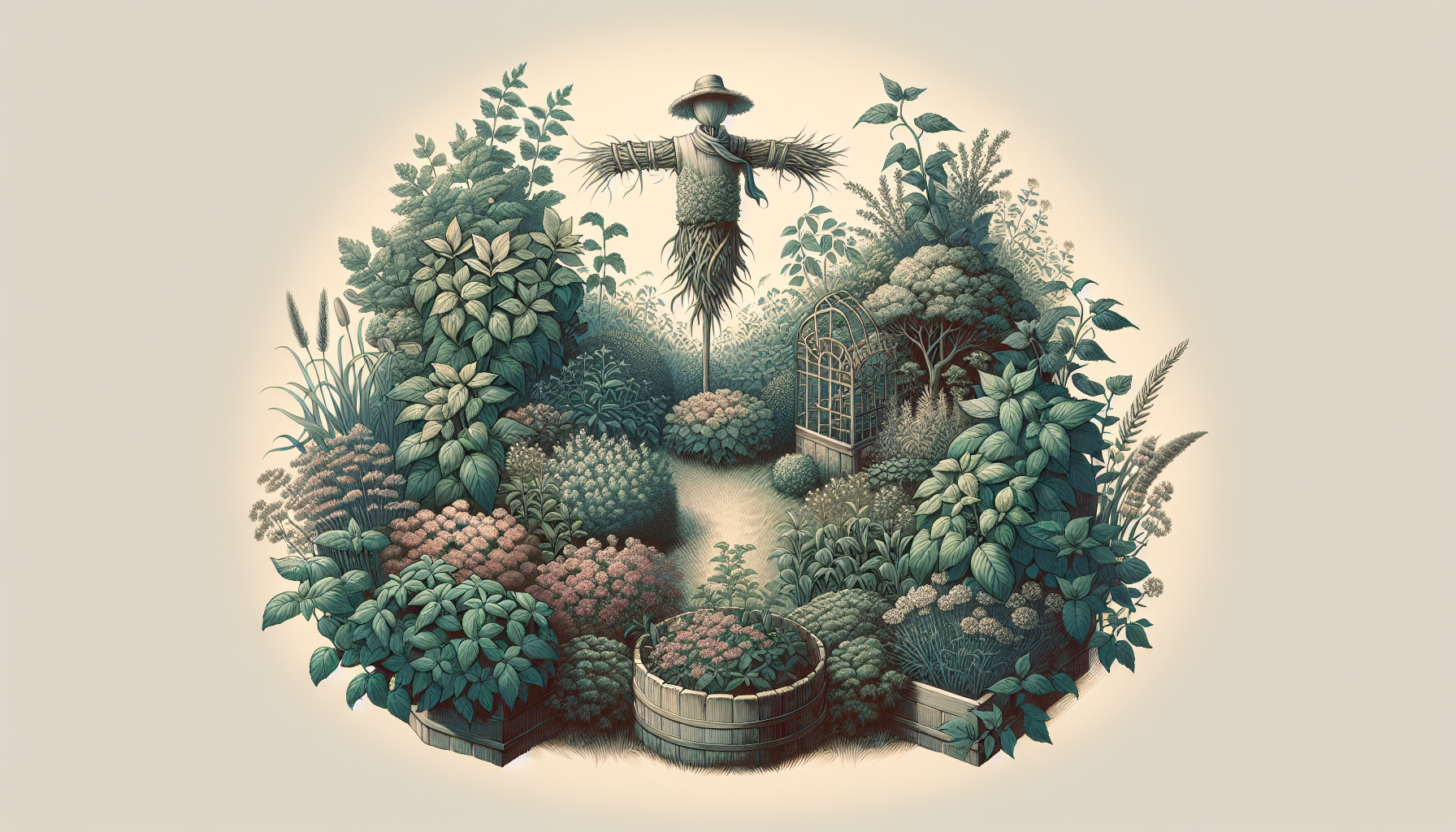So you’ve worked hard to grow your own herb garden, investing time and effort into nurturing those aromatic and flavorful plants that enhance your culinary creations. But now comes the challenge of protecting your precious herbs from potential threats. Whether it’s pesky pests, unpredictable weather, or curious animals, ensuring the safety and longevity of your herb garden can be a daunting task. But fear not, dear gardener, for in this article, we will explore a range of simple yet effective methods to safeguard your herb garden, allowing it to thrive and grace your kitchen with its bountiful offerings.
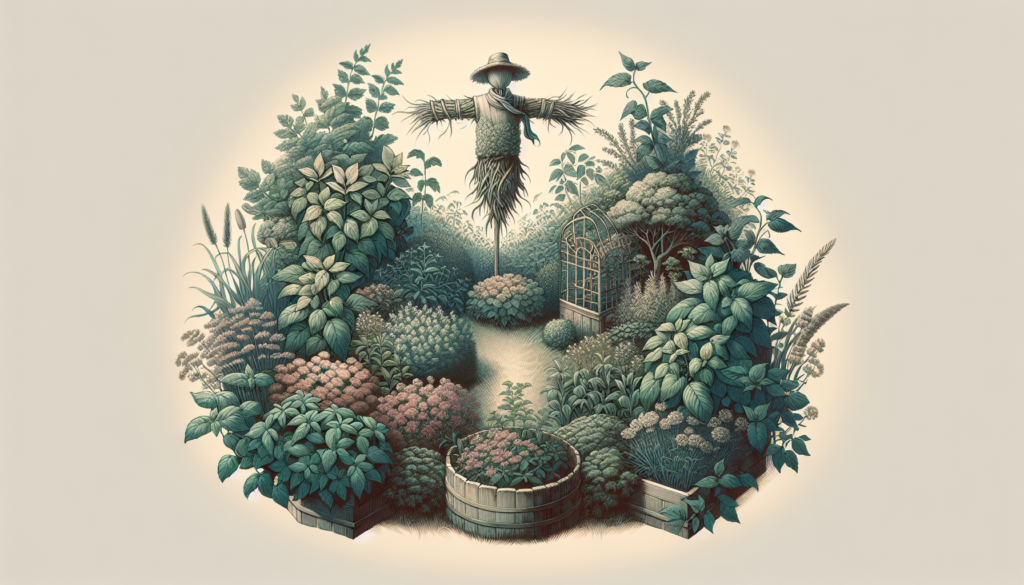
Choosing the Right Location
Sunlight requirements
When choosing a location for your herb garden, it’s important to consider the sunlight requirements of different herbs. Most herbs thrive in full sun, which means they need at least six hours of direct sunlight per day. However, some herbs, like mint and parsley, can tolerate partial shade. Make sure to observe the amount of sunlight your chosen spot receives throughout the day to ensure it meets the needs of your herbs.
Temperature considerations
Temperature is another crucial factor to consider when selecting a location for your herb garden. Most herbs prefer temperatures between 60 and 70 degrees Fahrenheit (15 and 21 degrees Celsius). Avoid planting herbs in areas with extreme temperature fluctuations or where they may be exposed to cold drafts. Consider placing your herb garden in a sheltered location that provides some protection against frost and extreme heat.
Protection from wind
Herbs, especially those with delicate leaves, can be susceptible to damage from strong winds. To protect your herb garden from wind, choose a location that provides natural barriers such as fences, hedges, or buildings. If your chosen spot is still prone to strong winds, consider installing windbreaks or using trellises and stakes to provide additional support and protection for your herbs.
Garden Bed Preparation
Clear the area
Before starting your herb garden, it’s essential to clear the area of any weeds, grass, or other vegetation. Remove all existing plants and dig up the soil to ensure a clean bed for your herbs. This will help prevent competition for nutrients and reduce the risk of weed growth within your herb garden.
Improve soil quality
To create an optimal growing environment for your herbs, it’s important to improve the quality of the soil in your garden bed. Test the soil’s pH level and ensure it falls within the recommended range for herbs, which is typically between 6.0 and 7.0. Amend the soil with organic matter, such as compost or well-rotted manure, to improve drainage, nutrient retention, and overall soil fertility.
Layout and design
Consider the layout and design of your herb garden to maximize its functionality and visual appeal. Plan the arrangement of your herbs based on their height, growth habits, and compatibility. Group herbs with similar watering needs together to simplify the irrigation process. You can also incorporate decorative elements, such as raised beds or pathways, to enhance the aesthetic appeal of your herb garden.
Plant Selection
Choosing the right herbs
When selecting herbs for your garden, consider both your personal preferences and the specific growing conditions in your area. Popular culinary herbs like basil, thyme, rosemary, and oregano are excellent choices for beginners. Additionally, research the individual care requirements of each herb to ensure you can provide the necessary conditions for their growth.
Companion planting
Companion planting involves growing different plants together to benefit one another. In the case of herb gardening, certain combinations can help repel pests or enhance each other’s growth. For example, planting mint near cabbage can deter cabbage worms, while planting chamomile near basil can promote stronger growth. Research companion planting strategies to maximize the health and productivity of your herb garden.
Considerations for container gardening
If you don’t have access to a suitable outdoor space or if you prefer a more portable option, container gardening is a great alternative for growing herbs. Choose containers with adequate drainage holes and use a well-draining potting mix specifically formulated for container gardening. Remember to monitor the moisture levels and water your herbs accordingly, as containers can dry out more quickly than garden beds.
Pest Prevention and Control
Identify common herb garden pests
To effectively prevent and control pests in your herb garden, it’s crucial to identify the common culprits. Some frequent herb garden pests include aphids, slugs, snails, caterpillars, and spider mites. Pay attention to signs of damage and any visible pests on your herbs to determine the appropriate course of action.
Natural pest control methods
Implementing natural pest control methods is not only environmentally friendly but also safer for your herbs and beneficial insects. Consider methods such as handpicking pests, introducing predatory insects like ladybugs, or using insecticidal soaps made from natural ingredients. Encouraging biodiversity in your garden can also help create a balance that naturally keeps pests in check.
Using organic pesticides
When natural pest control methods are not sufficient, or if you’re dealing with severe pest infestations, organic pesticides can be an effective option. Look for organic pesticides that are specifically labeled for use on herbs and follow the instructions carefully. Always apply pesticides as a last resort and use them sparingly to minimize any potential negative impacts on the environment and beneficial insects.
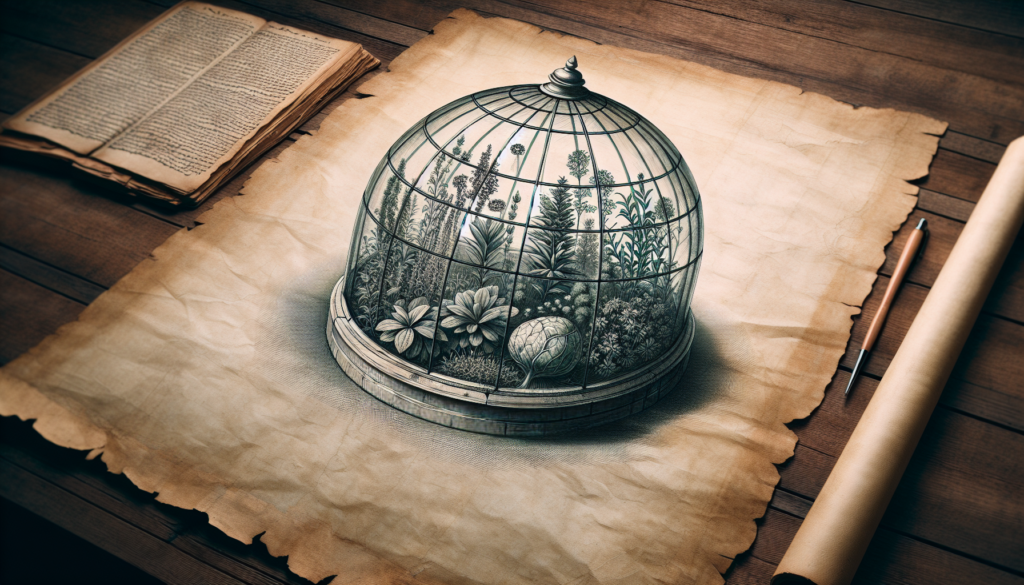
Weed Control
Mulching
One of the most effective ways to control weeds in your herb garden is by applying mulch. Mulching helps suppress weed growth by blocking sunlight and reducing soil moisture evaporation. Use organic mulch such as straw, wood chips, or shredded leaves to create a protective layer around your herbs. Apply a thick layer of mulch, around 2-3 inches deep, but avoid burying the base of your herb plants.
Hand weeding
Regular hand weeding is essential for maintaining a weed-free herb garden. Take the time to inspect your garden regularly and remove any weeds that appear. When pulling out weeds, make sure to remove the roots as well to prevent regrowth. Hand weeding is particularly useful for small herb gardens or when dealing with isolated weed problems.
Using herbicides
Herbicides should be used as a last resort when all other weed control methods have failed. When considering herbicides, choose selective herbicides that target specific weed types while minimizing damage to your herbs. Follow the instructions carefully, applying herbicides only to the affected areas and avoiding contact with your herb plants. Be aware that herbicides can have adverse effects on the environment, so use them sparingly and responsibly.
Watering Techniques
Establishing a watering routine
Consistent watering is vital for the health and productivity of your herb garden. Establishing a watering routine ensures that your herbs receive adequate moisture without overwatering or underwatering. The frequency of watering will depend on various factors such as the weather, soil type, and the specific water needs of your herbs. Monitor the soil moisture regularly and adjust your watering routine accordingly.
Proper watering techniques
When watering your herb garden, aim to maintain even moisture levels throughout the root zone. Water your herbs at the base, near the soil level, rather than overhead to prevent the foliage from staying wet for extended periods, which can lead to fungal diseases. Avoid excessive watering, which can cause root rot, and aim for deep watering rather than frequent shallow watering to encourage healthy root development.
Using irrigation systems
Consider using irrigation systems, such as drip irrigation or soaker hoses, to simplify and automate the watering process in your herb garden. These systems deliver water directly to the base of your herbs, avoiding unnecessary moisture on the foliage. Irrigation systems are especially beneficial for larger herb gardens or when you need to water multiple plants simultaneously.
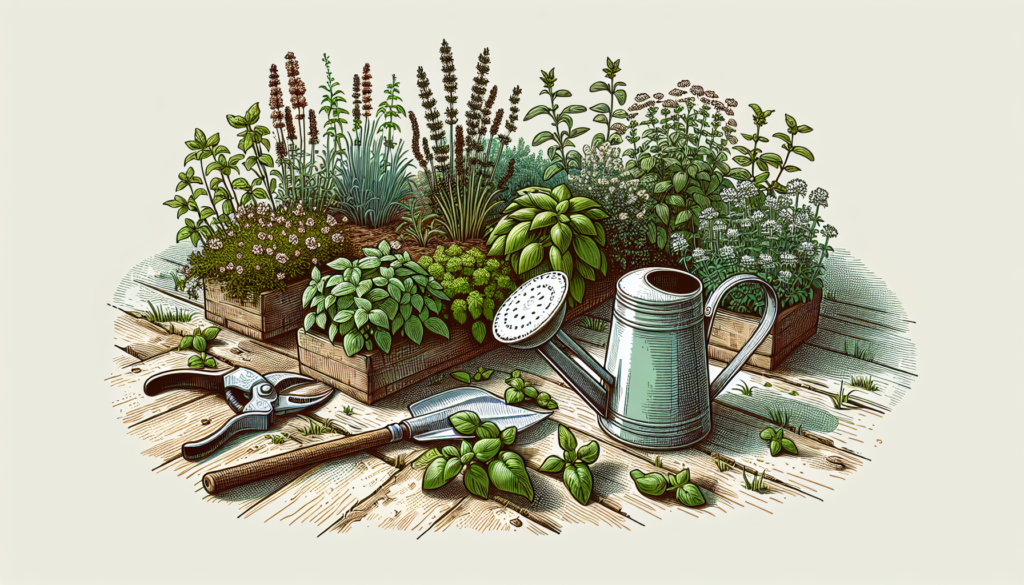
Fertilization and Soil Amendments
Understanding nutrient requirements
Proper fertilization is essential to provide your herbs with the necessary nutrients for healthy growth. Each herb has specific nutrient requirements, so it’s crucial to understand their individual needs. Nitrogen, phosphorus, and potassium are the primary macronutrients required for plant growth, but herbs may also benefit from secondary and micronutrients. Regularly testing your soil and adjusting your fertilization practices accordingly can help ensure optimal nutrient levels for your herbs.
Organic fertilizers
Organic fertilizers are a great choice for herb gardening as they provide nutrients in a slow-release form and contribute to long-term soil health. Common organic fertilizers include compost, aged manure, and organic matter-rich amendments like bone meal or fish emulsion. Apply organic fertilizers according to the manufacturer’s instructions or as recommended by soil test results to avoid overfertilization.
Composting
Composting not only reduces waste but also provides a nutrient-rich amendment for your herb garden. Start a compost pile using kitchen scraps, yard waste, and other organic material. Once the compost is fully decomposed, apply it to your garden beds or mix it into potting soil for container gardening. Compost improves soil structure, fertility, and moisture retention, which are all essential for the health of your herbs.
Harvesting and Pruning
Timing your harvest
Harvesting your herbs at the right time ensures optimal flavor and quality. Each herb has its own ideal harvest time, so familiarize yourself with the specific requirements of each herb you’re growing. Generally, herbs should be harvested before they flower to maximize their essential oil content. Regularly harvesting your herbs also promotes healthy growth and reduces the risk of plants becoming overgrown or unproductive.
Proper pruning techniques
Pruning is an important practice for maintaining the shape and vigor of your herb plants. Prune your herbs regularly to remove dead or damaged foliage, encourage bushier growth, and prevent the plants from becoming leggy. Use sharp, clean pruning shears and make clean cuts just above a leaf node or a set of leaves. Avoid pruning more than one-third of the plant’s foliage at a time to prevent stress.
Benefits of regular pruning
Regular pruning offers numerous benefits to your herb garden. Pruning stimulates new growth, enhances air circulation, prevents overcrowding, and improves light penetration, all of which contribute to healthier and more productive herbs. Additionally, pruning can help control the size of your plants, ensuring they remain manageable and aesthetically pleasing within the herb garden.
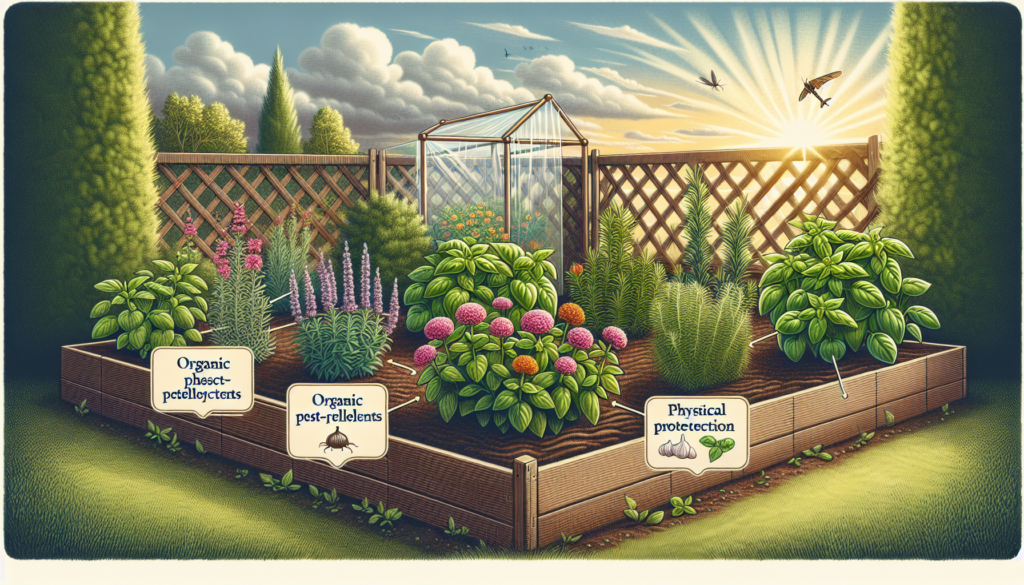
Disease Prevention and Treatment
Common herb diseases
Preventing and treating diseases is crucial for the overall health and survival of your herb garden. Some common herb diseases include powdery mildew, fungal leaf spots, root rot, and bacterial blight. Observe your plants regularly for signs of disease, such as yellowing leaves, wilting, or unusual spots, and take appropriate action to prevent the spread of disease.
Sanitation practices
Maintaining good sanitation practices is essential for disease prevention in your herb garden. Keep your herb garden clean by removing fallen leaves, debris, and any infected plant material. Disinfect your gardening tools regularly with a bleach solution to prevent the spread of disease. Avoid overwatering and provide adequate spacing between plants to promote airflow and reduce moisture buildup, which can lead to fungal infections.
Using fungicides
In some cases, despite best prevention practices, fungal infections may still occur. If your herb garden is experiencing persistent fungal diseases, it may be necessary to use fungicides. Choose organic or chemical fungicides labeled specifically for use on herbs and follow the instructions carefully. Remember to wear protective clothing and take precautions to minimize exposure to yourself and beneficial insects.
Seasonal Protection
Preparing for winter
As the weather starts to cool, it’s important to prepare your herb garden for winter. Trim back any dead foliage and remove annual herbs that have finished their growing season. Apply a layer of mulch around perennials to protect their roots from freezing temperatures. Consider covering sensitive herbs with frost cloths or bringing potted herbs indoors to protect them from harsh winter conditions.
Protecting plants from frost
During periods of frost, take extra precautions to protect your herb plants. Cover them with blankets or frost cloths overnight to shield them from freezing temperatures. Avoid using plastic covers directly on the plants, as this can trap moisture and cause damage. Proper protection from frost will help ensure the survival of your herbs and promote healthy growth in the following season.
Providing shade during hot summers
In hot summer months, herbs may suffer from excessive heat and sun exposure. Provide shade for your plants by using shade cloths, umbrellas, or planting them strategically near larger plants or structures that offer natural shade. Mulching can also help retain soil moisture and moderate soil temperature, which can alleviate heat stress on your herbs during the summer season.
By following these comprehensive guidelines, you can protect your herb garden and provide optimal growing conditions for your herbs throughout the year. Enjoy the process of nurturing your herbs and reap the rewards of a bountiful harvest and a beautiful herb garden.

